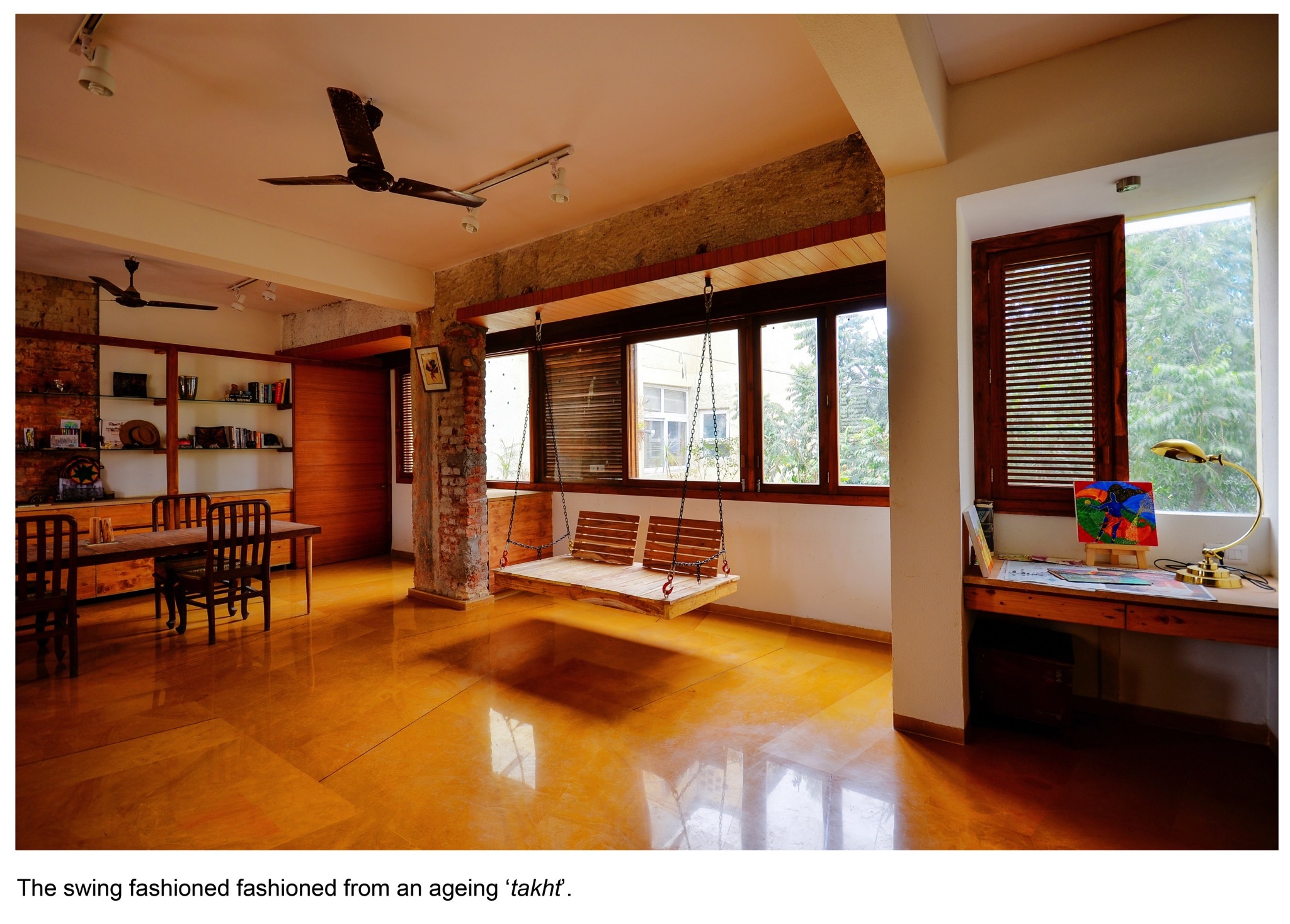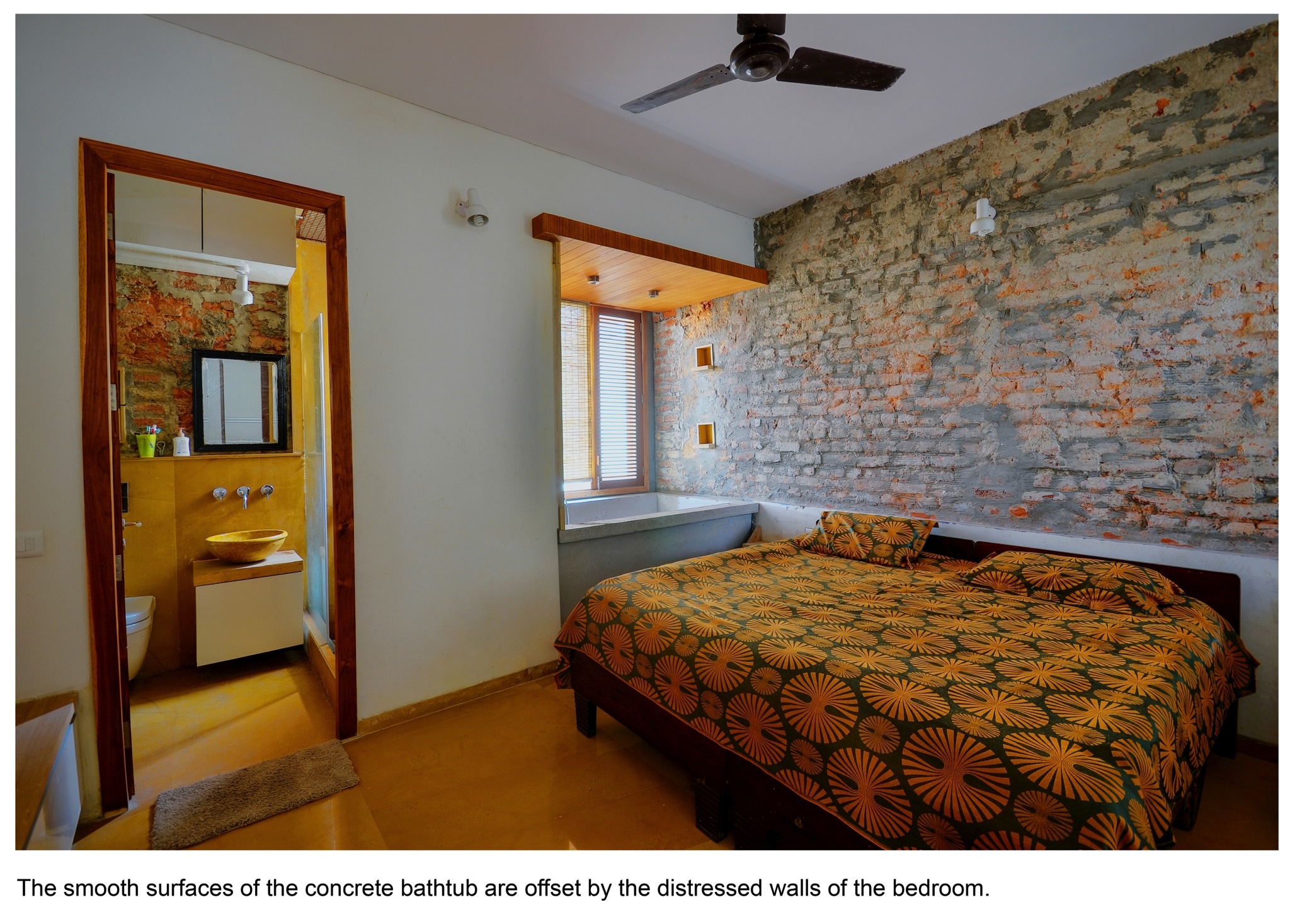1652 : Architects abode
“Design is not making beauty. Beauty emerges from selection, affinities, integration, love.” Luis Khan
Apartment 1652. ‘The house of the rising sun’
Built-up area – 1300 sq ft
Year of completion – 2014
“1652”
The House of the Rising Sun
1652 is designed on the ephemeral connection between sunlight and space. The flow of spaces follows the passage of the sun, from sunrise to sunset, as the daily activities of the inhabitants, man and animals dance along its designed solar path.
1652 is an interior renovation project for an architect-artist couple, their two cats and a dog. The apartment is situated on the top floor of a multi storied apartment complex.
Their day begins early, with the rising sun in the slanted glass kitchen-utility with the bright rays of the sun playing on the Jaisalmer counter top as the coffee brews. From the utility, spilling over through the packing wood louvered partition, the radiance of the sun catches the courtyard style living room. With its circular columns and large sliding windows opening out to the surrounding foliage, and the hanging takhat- seating, the family lazily sips in the morning. The wooden windows, with louvers made of salvaged wood, are framed along the top by a kutcha plywood arch. By mid-morning, the kitchen is abuzz with the warm sparkle of the sun, and the white onyx counter and golden packing wood cabinets add a touch of glamour to the otherwise earthly décor. From the south-side balcony, the golden sun stirs up the dining room, and the family settles down for a lively breakfast. The dining room with its stripped bare column and naked brick wall has an ethnic rustic vibrancy, balanced by high gloss laminate and the sleek curved wooden base of breakfast table.
By late morning, as the humans leave for work, and the sun shifts towards the bedrooms, the animals settle in for a lazy snooze under the blanket sun. The bedrooms themselves have naked brick and cement walls, their roughness again offset by high-designed, white gloss laminate cupboards with bamboo hanger rods and wooden pull-out drawers. The master bedroom window has been renovated as a deep two person exposed cement bathtub with a wooden veneer ceiling.
As evening approaches, the family settles in the den for a quiet evening of chatting, painting or watching movies. The television area has been designed with teak-wood stone counter tops and wooden louvered wall panels. This is juxtaposed against a naked wall with cement arched niches expressing an ethnic Indian aura.
All in all, 1652 is an experience of passive-design and modern vocabulary under the wrappings of an Indian appearance. It is perhaps an expression of postmodern Indian art searching for its unique global identity.
Sustainable measures
Construction Materials – Over 90% building material (wood, board, hardware, sanitary fittings, plumbing and electrical, etc) has been sourced from within 5 km of the site to reduce embodied energy spent in transporting materials over long distances. The architects encouraged reuse of salvaged building material, as well as building material with high recycled content. All civil structure material (i.e. sand, cement, bricks and stone agg) has been procured from within 500 meters of the site, and transported by bullock carts.
Day Lighting and Cross Ventilation – The spaces are designed to be adequately day-lit with ample shading and openings for cross ventilation. This eliminates the need for any artificial lighting or mechanical cooling during the day, saving energy and providing healthy indoor air quality. Leftover ONYX stone was used to fashion translucent lighting fixtures, for the outdoor terrace areas.
Energy – the opening on the sun-facing sides of the apartment have wooden louvers to break the sun into shadow and protect the glass panes from heat. CFL and LED lighting has been used to reduce energy costs.
Greenery – Old / decaying G.I plumbing pipes were removed from the bathrooms and kitchen and welded to form planters and sunshades. These planters have been placed along the openings on the external walls based on sunlight requirements, and have been oriented towards relevant views.
Malba and masonry – Waste building material and ‘malba’ obtained from demolishing was used to create foundations for the boundary walls of the studio at the lower floor.
Metal – All window grills removed from the existing windows were reused as part of the boundary wall. Extruded wire mesh and mosquito netting was reused to create ‘grids above shower cubicles in the bathrooms, to allow for creepers and foliage to grow and entwine creating ‘green’ false ceilings.
Shuttering/ Scaffolding Material – Scaffolding material (bamboo + eucalyptus) was reused to create coverings for the rainwater drains, bookshelves, clothes hanging rods in cupboards and full length dressing mirrors.
Stone – Leftover Jaisalmer stone was reused as ‘crazy’ patterned floors and walls at the studio and bathrooms, Leftover onyx and Jaisalmer was used to create ‘lighting fixtures’.
Walls / Brick – Bricks obtained after demolishing were used to create boundary walls and patterned floors for our studio resulting in minimal fesh brick requirements. Walls were stripped of plaster to create ‘feature walls’.
Water – The use of low-flow fittings, re-polished bathroom fittings and use of old sanitary fittings as planters keeps up with the ‘sustainable’ gestures employed by the architects to design their space.
Woodwork – Old wooden windows were separated into individual members and resized to create new windows and louvers. The existing doors were resurfaced with plywood and veneer to create new doors. Handles have been designed with leftover wooden pieces. Recycled packing wood has been used for cabinet shutters and accessories (towel hangers, step ladder/bed side table).




































